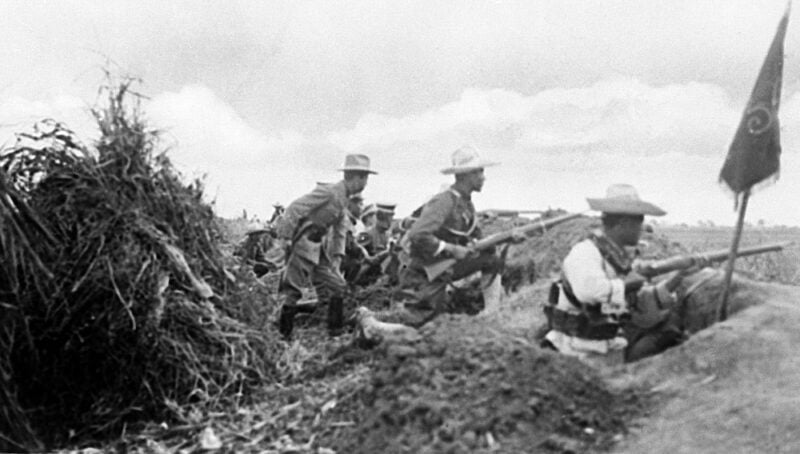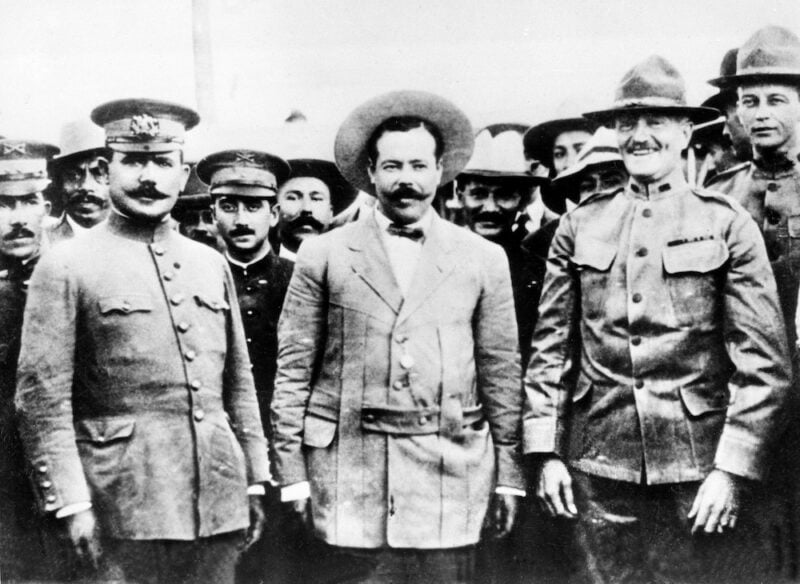Amelio Robles Avila: Trans Man Who Fought in Mexican Revolution

Amelio Robles Avila poses in a 1915 photograph. (Source)
Updated August 31, 2024
October 14, 2022 ~ By Shari Rose
Amelio Robles Avila was a trans Mexican man who became a colonel during the Zapatista movement, fought under General Alvaro Obregon, and lived to be 95 years old
During the Mexican Revolution, Amelio Robles Avila began his military career as a guerrilla fighter and ended it as a colonel with more than 300 men in his command. But that was not the only revolution he fought in. As a transgender man living in Mexico, Robles also fought to achieve acceptance for his gender identity at a time when the society he was born into was overwhelmingly binary.
Amelio Robles’ Early Life
On November 3, 1889, Amelio Robles was born in Xochipala, Mexico. The third child in a family of ranchers living in a rural area of southwestern Mexico, he was assigned female at birth and given the name, Amelia Robles Avila.
From a young age, Robles gravitated toward the activities and skills that other boys in his town participated in. While being raised as a girl by his family, he also learned how to handle weapons, ride horses, and fight. Growing up, Robles attended a local Catholic girls’ school called Society of the Daughters of Mary of the Miraculous Medal. By age 12, he was well-trained in performing all the expected tasks and duties of young Catholic girls.
Nonetheless, Amelio Robles continued to pursue interests and goals that contradicted this strict, binary upbringing. As he grew into an adult, he became an excellent marksman and horseman, with dreams of becoming a soldier. That dream would become a reality as the Mexican Revolution came knocking on his door.
- More stories: The Lack of U.S. Latino Representation in TV Shows & Films
- More stories: Lucy Hicks Anderson: Black Transgender Pioneer of the 1940s
- More stories: Aztec Architecture: Floating Gardens & Aqueducts in Tenochtitlan
Robles’ Involvement in the Zapatista Movement
When talk of social and political revolution reached his home in Guerrero, Robles excitedly took up arms and enlisted in the fight. By this point in his life, he fully identified as a transgender man, dressing and behaving like any other Mexican male at the turn of the 20th century. He chose the name, Amelio, and was known by everyone as Amelio Robles Avila until he died.
In 1912, Robles joined the Zapatista Movement as a 23-year-old guerrilla fighter, and discovered he loved the lifestyle of a soldier. During this experience, he wrote that being a guerrilla fighter allowed him the “sensation of being completely free.”

Emiliano Zapata in a 1911 photograph. (Source)
The Mexican Revolution was a period of intense social and political transformation for all generations of Mexicans. Nationalism swept the country, and the notion of masculinity became inextricably intertwined with patriotism.
These social changes actually worked in favor of Robles’ acceptance as a transgender man. His embrace of masculinity as well as his impressive fighting skills on the battlefield convinced many of those around him to tolerate and even accept his gender identity. As a trans man, Amelio Robles Avila embodied many of the values and ideals that were associated with what it meant to be a true patriot during the Mexican Revolution.
When Robles’ story became known to a journalist named Miguel Gil in Mexico City, he sought to meet the guerrilla fighter. Robles was interviewed, photographed, and placed on the front page of El Universal, one of Mexico’s largest newspapers. In the now-famous photograph, Robles proudly poses while holding his personal pistol and a cigarette. This brush with fame, though brief it may be, gave him the opportunity to portray himself as he wanted to be understood by the rest of the world.
- More stories: Crystal LaBeija: Iconic Drag Queen Who Established House System
- More stories: Riot Dogs: El Vaquita, Loukanikos & Others Who Joined Protesters Against Police
- More stories: Police Killings of Latinos in Los Angeles: 2016 – 2021
Amelio Robles Embraces Machismo During the Mexican Revolution
It should be noted that during the Mexican Revolution, many women served alongside their male counterparts on the battlefield. Often dressing in masculine clothing, these women were known as soldaderas. They typically tended to the wounded, cooked meals, performed maintenance on weaponry, and more.
However, soldaderas presented themselves as male to protect themselves from sexual violence and break free from the gender restrictions that prevented them from participating in much of Mexican society. Though he likely interacted with many soldaderas throughout his service during the revolution, Amelio Robles Avila was a transgender man, not a soldadera.

Soldiers fighting for the Obregon Army shoot from shallow trenches in 1924. Amelio Robles Avila served under Alvaro Obregon from 1923 to 1924. (AP Photo)
As part of his transition, Robles leaned into the notion of machismo, an exaggerated and often aggressive form of masculine pride in Mexican culture. In a way, his adoption of these ideals fortified the strict patriarchal barriers that sought to forbid lifestyles like his own. Historian Gabriela Cano wrote about this seemingly contradictory choice in Robles’ life, saying in part:
“The paradox was Robles’ successful gender transition simultaneously subverted and reinforced normative heterosexuality and stereotypical masculinity it re-created.”
Robles’ Military Service After the Revolution
Robles remained a guerrilla fighter in the Zapatista Movement until about 1918. During that period, he rose through the ranks to become a colonel, or coronel, with more than 300 men in his command. It’s believed he was shot six times throughout his service. After the assassination of Emiliano Zapata, Robles joined the Mexican Army. He continued to love the lifestyle that the military offered him, and he fought under the command of Adrian Castrejon.
From 1923 to 1924, Robles joined Alvaro Obregon’s forces and fought at the Agua Prieta Revolt. While serving in Hidalgo, he was shot and discharged from the Mexican Army.

Pancho Villa, center, poses with Gen. John J. Pershing, right, and Gen. Alvaro Obregon, left, at Fort Bliss, near El Paso, TX, on August 27, 1914. (AP Photo)
Due to his strategic mind and courage on the battlefield, he made powerful friends in the military, many of whom went into politics after the revolution. These allies helped legitimize Robles’ transgender identity in broader Mexican society.
Still, Robles endured much discrimination and violence as a transgender man. After the Mexican Revolution, he was initially unable to settle down in his hometown of Xochipala because he received death threats and was nearly killed by other soldiers when he visited. He moved to Iguala for a time before eventually returning home in southwestern Mexico.
- More stories: Zazu Nova’s Legacy at Stonewall Deserves Recognition
- More stories: How Ruben Salazar Gave Voice to Chicanos Until He Was Killed by Police
- More stories: Otherside Lounge: 1997 Bombing of Lesbian Bar in Atlanta
Amelio Robles Avila’s Later Years & Death
Robles pursued romantic relationships with women, and married a woman named Angela Torres in the 1930s. He did not perform the domestic chores he had learned as a child, but rather took on the roles and responsibilities of a typical Mexican man of the era.
Robles’ family largely accepted his gender identity, and he was known as a tío (uncle) and primo (male cousin) to his extended family. In fact, many of his nieces and nephews did not know he was a trans man until they became adults themselves.

Full-body portrait taken of Robles in 1915. (Source)
According to one neighbor who knew Robles, it was downright dangerous to misgender the former colonel: “I never addressed him as señora or madam, I also used Mr. Robles, because he would take out his pistol if anyone called him a woman or lady.”
In 1970, the Mexican Secretary of National Defense recognized Robles as a veterano, or male veteran, of the Mexican Revolution. This designation makes Robles the first known transgender soldier in Mexican history.
Nearly 15 years after the official recognition, Amelio Robles Avila died on December 9, 1984, at the age of 95.
Despite the national acknowledgement and respect for his identity a trans man, a movement grew to misgender Robles in the years after his death. This push likely stemmed from an effort to memorialize the women who served during the Mexican Revolution, but transphobia undoubtedly played a role in Robles’ erasure. About five years after he died, the “Amelia Robles Museum House” opened its doors. It erased his transgender identity entirely and instead counted him among the many women who fought in the revolution.
However, some commemorations of Robles’ life remain true to his life today. In his hometown of Xochipala, Guerrero, stands the Colonel Robles School (Escuela Primaria Urbana Federal Coronel Robles). This elementary school’s name correctly uses the masculine pronouns that Robles lived by for the vast majority of his long life.







0 Comments